Radio Frequency Systems W1000176 Fiber Fed Remote Unit User Manual
Radio Frequency Systems Inc Fiber Fed Remote Unit
User Manual
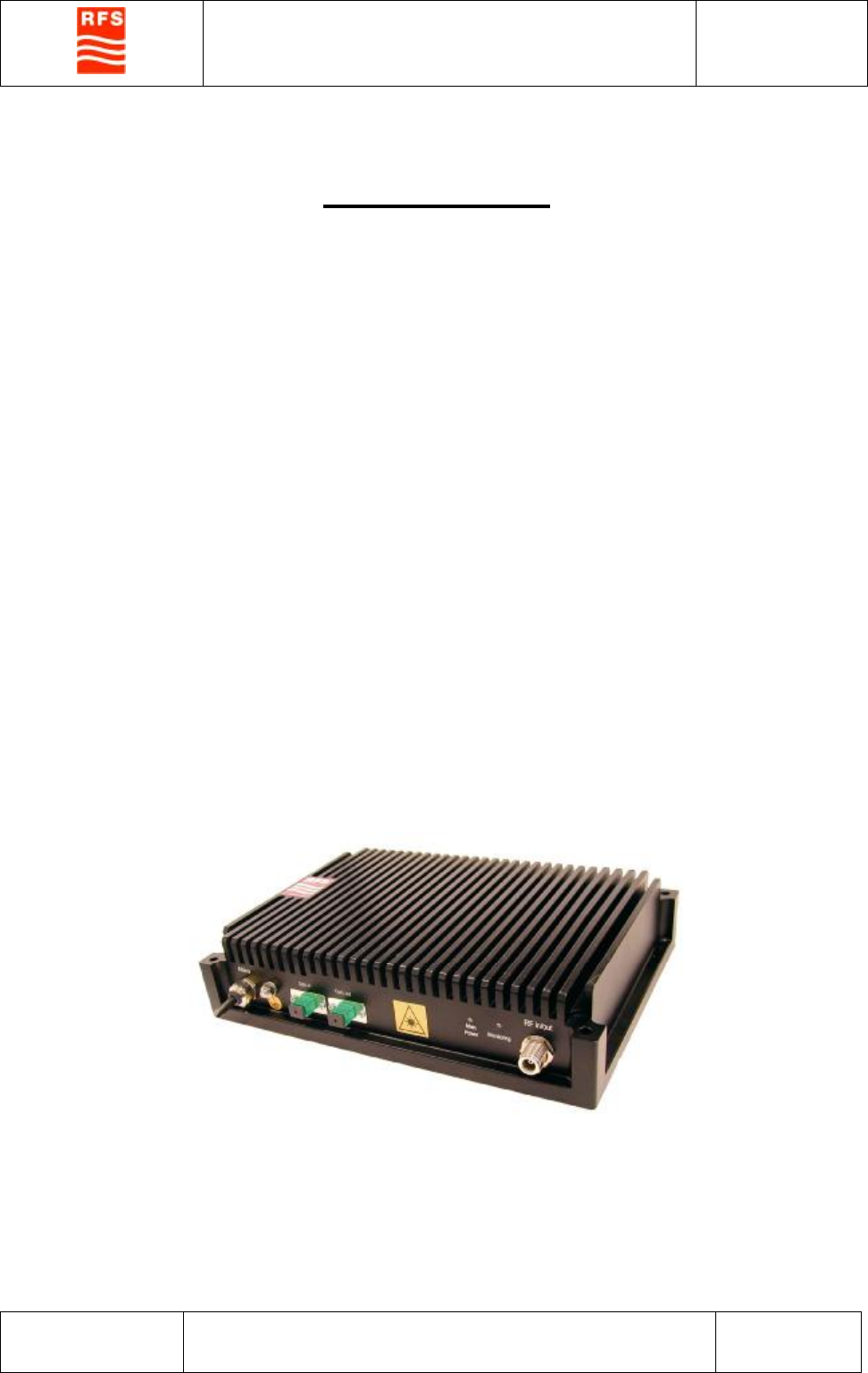
User Handbook L-RU Revision C
CONFIDENTIAL
PROPRIETARY Reg. No.: User Handbook 1100182-C.DOC Page 1 of 29
ClearFill®Space1
L-RU
(incl. L-RU800-2, L-RUSMR800-2, L-RU700-2, L-RU1900-2, L-RU1721-2)
User Handbook
Part. No.:
L-RU800-2: 16501014
L-RUSMR800-2: 16501015
L-RU700-2: 16501016
L-RU1900-2: 16501017
L-RU1721-2: 16501018
Radio Frequency Systems GmbH
Kabelkamp 20
D-30179 Hanover (Germany)
Tel.: +49 511 676 2731
Fax: +49 511 676 3750

User Handbook L-RU Revision C
CONFIDENTIAL
PROPRIETARY Reg. No.: User Handbook 1100182-C.DOC Page 2 of 29
Contents
1 GENERAL 4
1.1 IMPRINT 4
1.2 ABBREVIATIONS 5
2 DESCRIPTION OF CLEARFILL®SPACE1 SYSTEM 6
2.1 GENERAL SYSTEM PERFORMANCE 9
3 DESCRIPTION OF REMOTE UNIT 11
3.1 BLOCK SCHEMATICS OF THE REMOTE UNIT 12
3.2 FUNCTIONAL BUILDING BLOCKS OF THE REMOTE UNIT 14
3.2.1 Uplink 14
3.2.2 Downlink 15
3.2.3 Monitoring 15
3.2.4 Function of ALC 15
3.2.5 Duplexer 15
4 SPECIFICATIONS 16
4.1 ELECTRICAL SPECIFICATIONS 16
4.2 MECHANICAL SPECIFICATIONS 18
4.3 OPTICAL LINK 18
4.4 COMPLIANCE 18
5 MODULE DESCRIPTIONS AND SPECIFICATIONS 19
5.1 OPTICAL TRANSCEIVER 19
5.1.1 Optical Transmitter 19
5.1.2 Optical Receiver 19
5.2 POWER SUPPLY 19
6 INSTALLATION AND COMMISSIONING 20
6.1 GENERAL STATEMENTS 20
6.1.1 Safety Considerations / Sicherheitshinweise (English / Deutsch) 20
6.1.2 Packing List 20
6.2 INSTALLATION PROCEDURE 21

User Handbook L-RU Revision C
CONFIDENTIAL
PROPRIETARY Reg. No.: User Handbook 1100182-C.DOC Page 3 of 29
6.3 COMMISSIONING PROCEDURE 23
7 MAINTENANCE, REPAIR AND WARRANTY 24
7.1 INTRODUCTION 24
7.2 ROUTINE CHECKS 24
7.3 REPAIR 24
7.4 TROUBLESHOOTING 25
7.5 WARRANTY 28
8 NOTES 29

User Handbook L-RU Revision C
CONFIDENTIAL
PROPRIETARY Reg. No.: User Handbook 1100182-C.DOC Page 4 of 29
1 General
Thank you for selecting this RFS product. We are confident that you will find this product in
proper working order and meeting all stated specifications.
Please read this manual. A full understanding of product operation will support optimal per-
formance and prevent accidental damage not covered by the stated warranty.
1.1 Imprint
These operating instructions are published by
No reproduction (including translation) is permitted in whole or part e.g. photocopy, micro-
filming or storage in electronic data processing equipment, without the express written
consent of the publisher. The operating instructions reflect the current technical specifica-
tions at time of print. We reserve the right to change the technical or physical specifica-
tions.
Radio Frequency Systems GmbH
Kabelkamp 20
D-30179 Hanover (Germany)
Tel.: +49 511 676 2731
Fax: +49 511 676 3750

User Handbook L-RU Revision C
CONFIDENTIAL
PROPRIETARY Reg. No.: User Handbook 1100182-C.DOC Page 5 of 29
1.2 Abbreviations
ALC Automatic Level Control
BP Band-pass
BTS Base Transceiver Station
DAS Distributed antenna system
DL Downlink
EIN Equivalent Input Noise
EMI Electro Magnetic Interference
EN A standard established by the European Committee for Standardization
ETSI European Telecommunications Standards Institute
HP High-pass
HU Height Units
IEC International Electrotechnical Commission - International standards organization
dealing with electrical, electronic and related technologies
IP3 Third-order intercept point
MU Master Unit
ORx Optical receiver
OTRx Optical transceiver
OTx Optical transmitter
PCB Printed Circuit Board
POI Point of interception
PSU Power supply unit
PTFE Polytetrafluoroethylene
RoHS Restriction of Hazardous Substances
RU Remote Unit
TRx Transceiver (Transmitter-Receiver)
UL Uplink
WEEE Waste of Electrical and Electronical Equipment
WiFi Wireless Fidelity
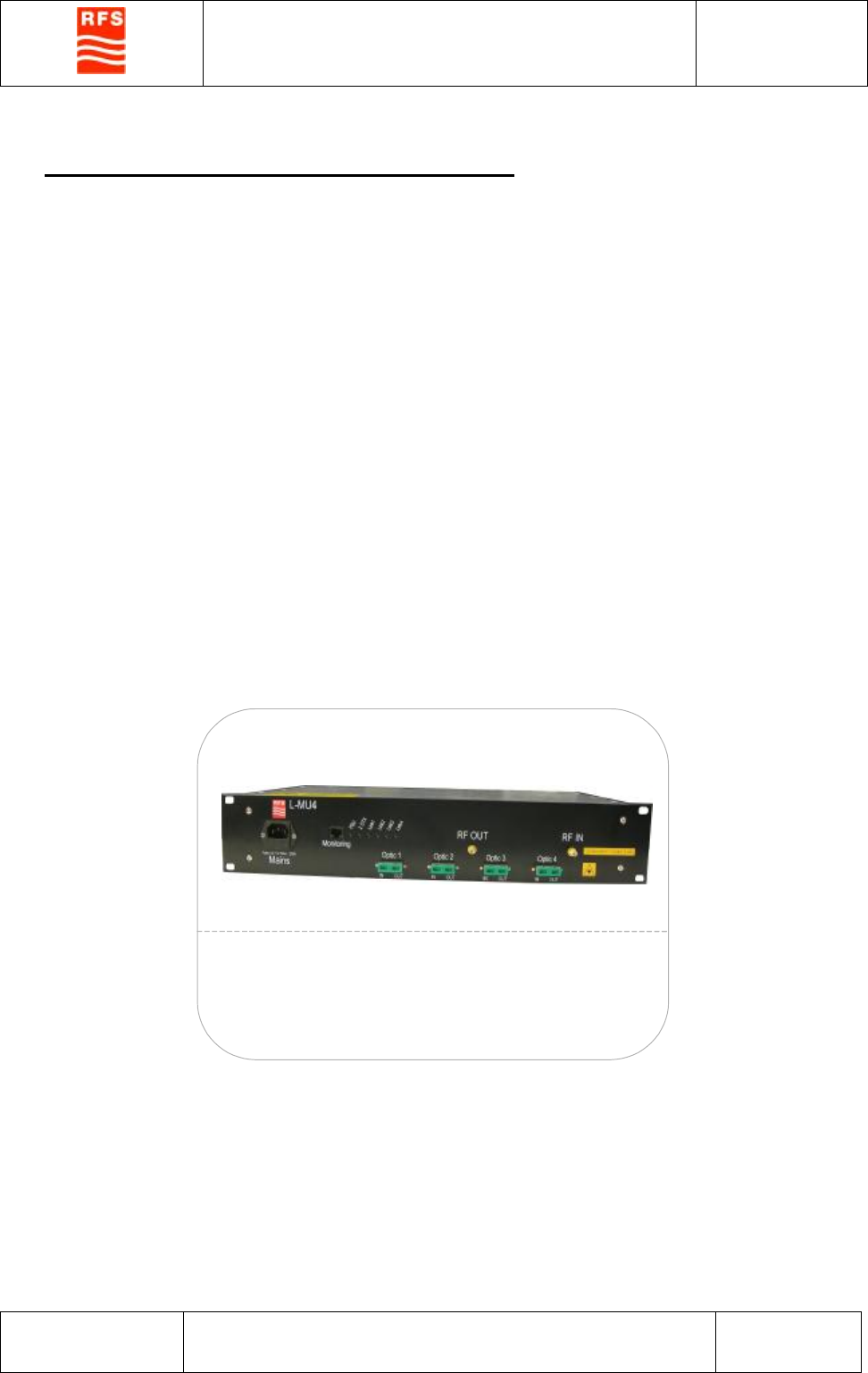
User Handbook L-RU Revision C
CONFIDENTIAL
PROPRIETARY Reg. No.: User Handbook 1100182-C.DOC Page 6 of 29
2 Description of ClearFill®Space1 System
When coverage is needed in a large building (typically larger than 200.000 sq ft), RF re-
peaters driving passive distributed antenna systems (DAS) often become impractical due
to their coaxial cable loss. ClearFill®Space1 is offering great value because the signal loss
in fiber is extremely low compared to coaxial cable. ClearFill®Space1 can provide excellent
coverage over broad areas.
ClearFill®Space1 is a mid power indoor coverage solution that meets any RF distribution
needs – from simple entry-level systems to the most complex applications.
ClearFill®Space1 is a modular RF-over-fiber distribution system that provides reliable and
highest quality indoor coverage of 2G and 3G wireless services in airports, hospitals, cam-
pus, enterprises, convention centers, high-rise buildings and tunnels.
The ClearFill®Space1 system is a plug-and-play fiber-optical repeater system consisting of
two main components: a Master Unit (MU) and Remote Units (RU), connected via a fiber-
optical link(s).
L-MU series Master Unit
L
-
MU1 drives one remote unit (band selective)
L-MU2 drives two remote units (band selective)
L-MU4 drives four remote units (band selective)
Figure 1 – Master unit L-MU of ClearFill®Space1
Three types of RF broadband MU are feeding one, two or four RU providing high level of
flexibility.
This handbook refers to the RU of a ClearFill®Space1 system. For further information
about the L-MU please refer to the User handbook L-MU.
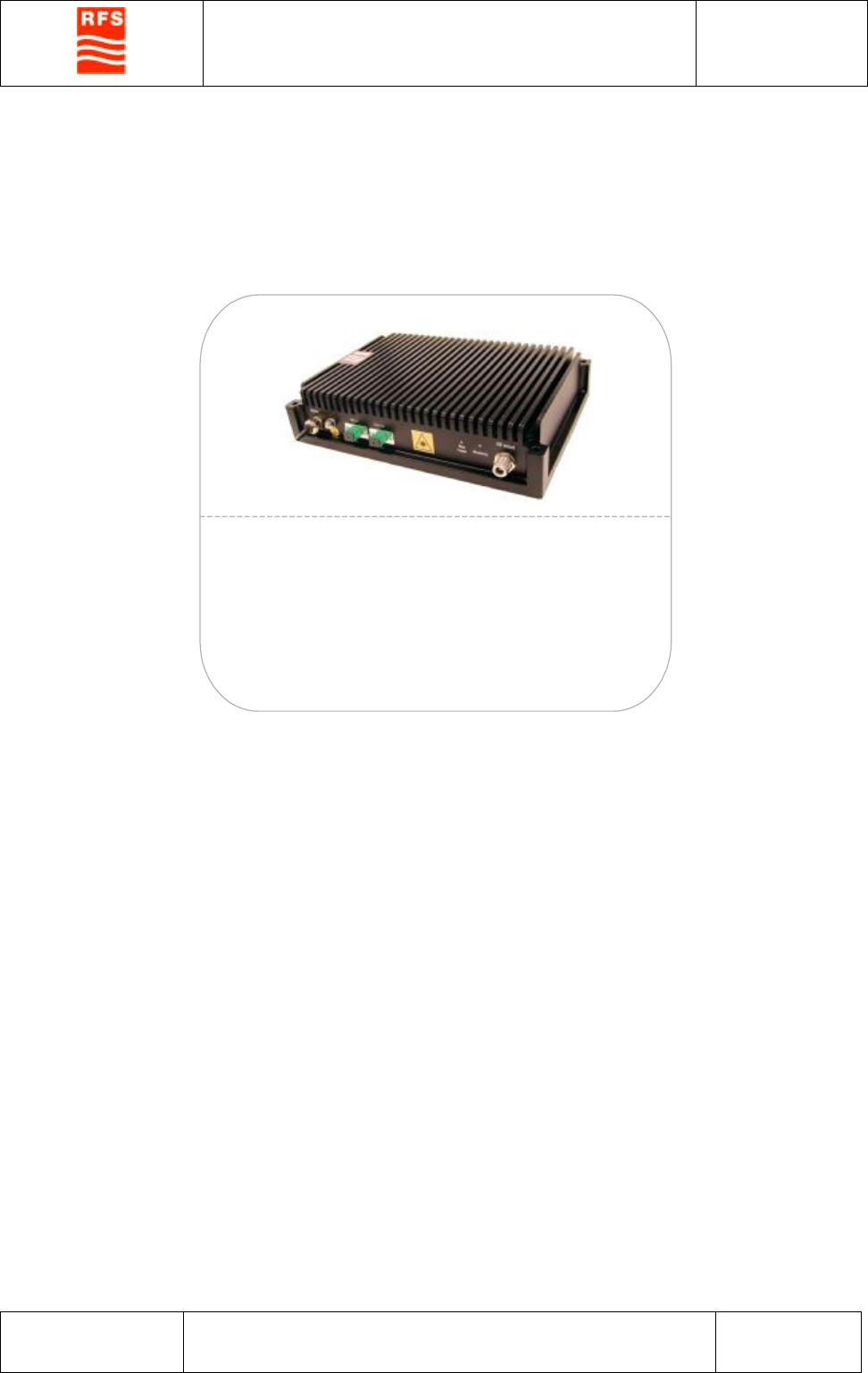
User Handbook L-RU Revision C
CONFIDENTIAL
PROPRIETARY Reg. No.: User Handbook 1100182-C.DOC Page 7 of 29
The RU is a fiber-fed, band-selective single-band RF amplifier. The automatically leveled
composite output power (22dBm, equivalent to 2x19dBm for two RF carriers) of a single
RU guarantees best coverage at low prices and is able to drive an area of typically 50.000
sq ft.
L
-
RU800
-
2
L-RUSMR800-2
L-RU700-2
L-RU1900-2
L-RU1721-2
for 50.000 sq ft
for 50.000 sq ft
for 50.000 sq ft
for 50.000 sq ft
for 50.000 sq ft
L-RU series Fiber Fed Remote Unit
Figure 2 – Remote unit L-RU of ClearFill®Space1
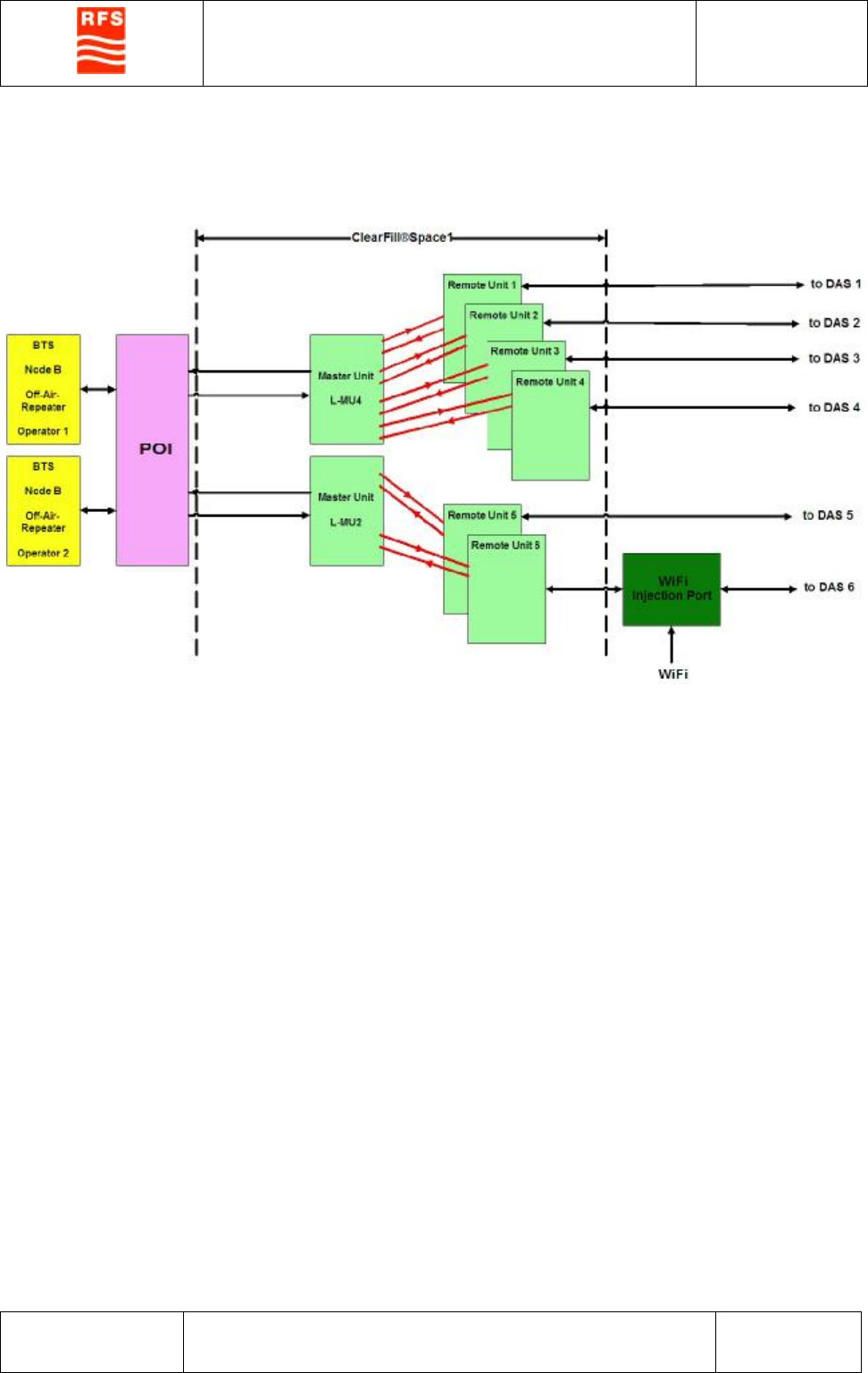
User Handbook L-RU Revision C
CONFIDENTIAL
PROPRIETARY Reg. No.: User Handbook 1100182-C.DOC Page 8 of 29
An example for a system topology is presented in Figure 3.
Figure 3 – Example of ClearFill®Space1 System Topology
Both devices (L-MU and L-RU) include an automatic level control (ALC) in uplink and
downlink that eliminates system gain variation, regardless of optical loss guarantying opti-
mised system performance under minimised installation effort.
The interface to the BTS / Node B or an Off-Air Repeater is the master unit. In case of a
multi-operator system a combining network (POI) has to be used in order to adapt the in-
put signal to the MU interface.
An opportunity to extend the system to distribute WiFi over the same DAS is foreseen via
RFS WiFi injection port.
L-RU
L-RU

User Handbook L-RU Revision C
CONFIDENTIAL
PROPRIETARY Reg. No.: User Handbook 1100182-C.DOC Page 9 of 29
2.1 General System Performance
Optical link:
• 0 to 6 dB optical attenuation
• Mono-mode fiber
Plug-and-play function:
• Self-leveling system in UL and DL
• Fixed output power levels of RU in DL
• Fixed output power levels of RU in UL for laser protection
• ALC of MU in DL for auto-leveling of composite input power for varying num-
ber of carriers
• ALC of MU in UL for auto-leveling of parallel optical links and compensating
for various optical link losses
• Commissioning effort reduced to a minimum
• Operating under ETSI requirements
Application:
• RU and MU build up an end-to-end RF system connected via a pair of optical fiber.
See User Handbook of Master Unit (L-MU series) for additional information about
MU.
• The system MU-RU and its plug-and-play functionality is designed to operate for
typical DAS applications with nominal UL input signal strengths (into RU RF in/out
port) in the range of -55 dBm to -35 dBm.
• As every distributed RF-over-fiber system, ClearFill Space1 introduces signal de-
lays in DL and in UL due to the use of single-mode optical fibers between MU and
RU. This delay has to be taken into account by cellular network planning/operation
for appropriate setting of BTS/NodeB search windows. This also applies for remote
BTS/NodeB’s which may be connected to a ClearFill Space1 system over-the-air
using an off-air repeater with donor antenna. Establishing a connection between
mobile / handheld device and BTS/NodeB may fail due to of improper setting of
search window / range.

User Handbook L-RU Revision C
CONFIDENTIAL
PROPRIETARY Reg. No.: User Handbook 1100182-C.DOC Page 10 of 29
Monitoring:
Managing the system in case of malfunction is very simple. Two alarm LED easily refer to
specific malfunction for the optical link connection and/or for the power supply. Correction
of an identified malfunction is done by exchange of faulty unit. Thus makes Clear-
Fill®Space1 a very service-friendly system.
LED specification and connectivity (Two type of alarm LED at RU):
• Green illuminated “Main power” LED indicates that the power is ON.
• Green illuminated “Monitoring” LED indicates that the received optical laser
signal from MU is functioning within spec.
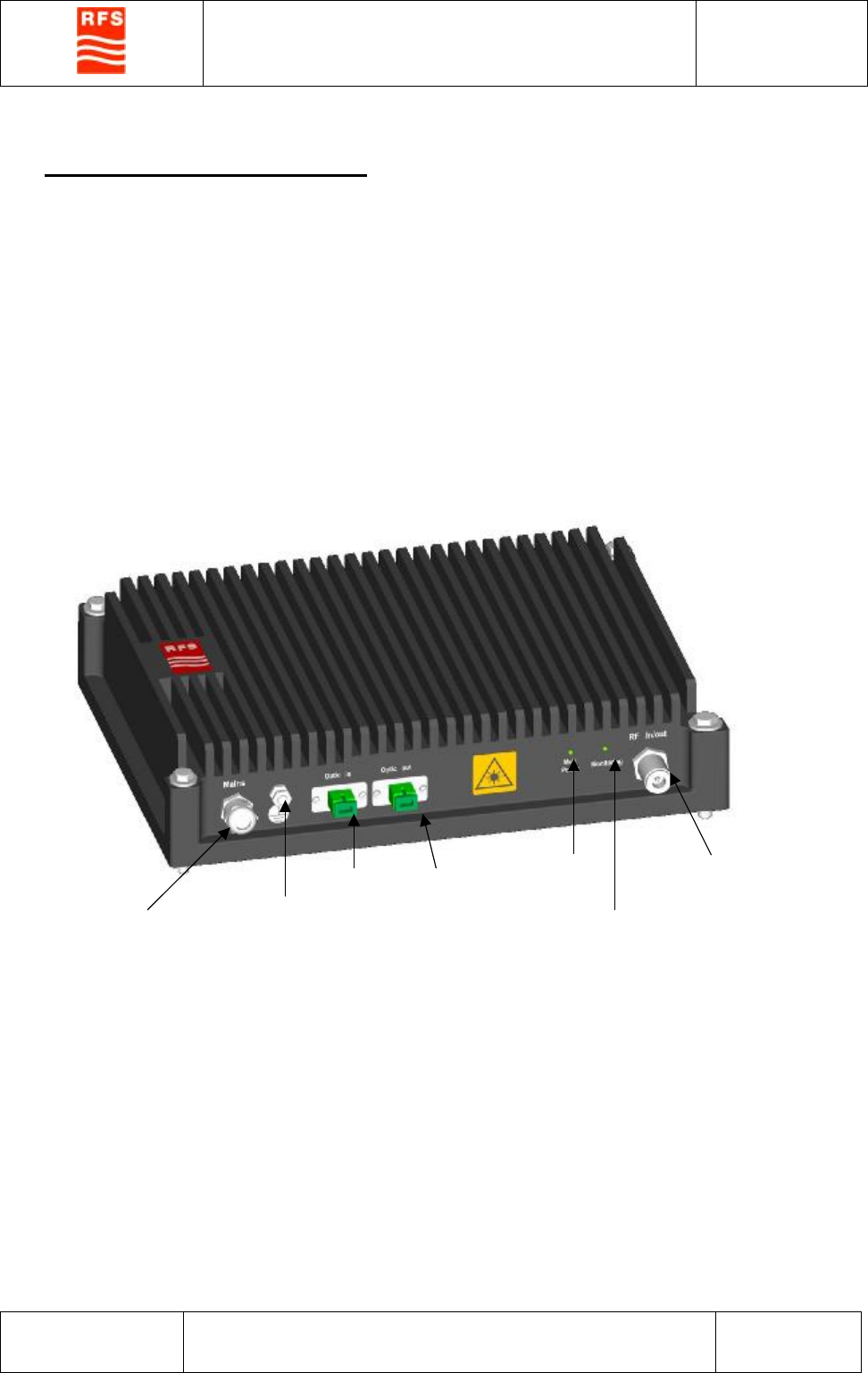
User Handbook L-RU Revision C
CONFIDENTIAL
PROPRIETARY Reg. No.: User Handbook 1100182-C.DOC Page 11 of 29
3 Description of Remote Unit
The medium-power RU is designed for applications in buildings and tunnels. Operating in
ALC modus in uplink and downlink the RU provides an easy plug-and-play handling with-
out system leveling. The output power level in downlink is fixed according to ETSI re-
quirements. The monitoring of function is locally indicated by LEDs. The summary alarm
switches the pilot tone to the optical Master Unit. The optical transceiver operates on
mono-mode fibers.
The remote unit comprises an optical transmitter and receiver, active and passive RF
components, and a single RF input / output port.
RF IN / OUT
Connector
LED Monitoring
AC Power
Cable
(not shown)
Earthing Clamp
DL
Optic in
SC/APC
connector
UL
Optic out
SC/APC
connector
LED
Mains
Figure 4: Picture of Optical Remote Unit
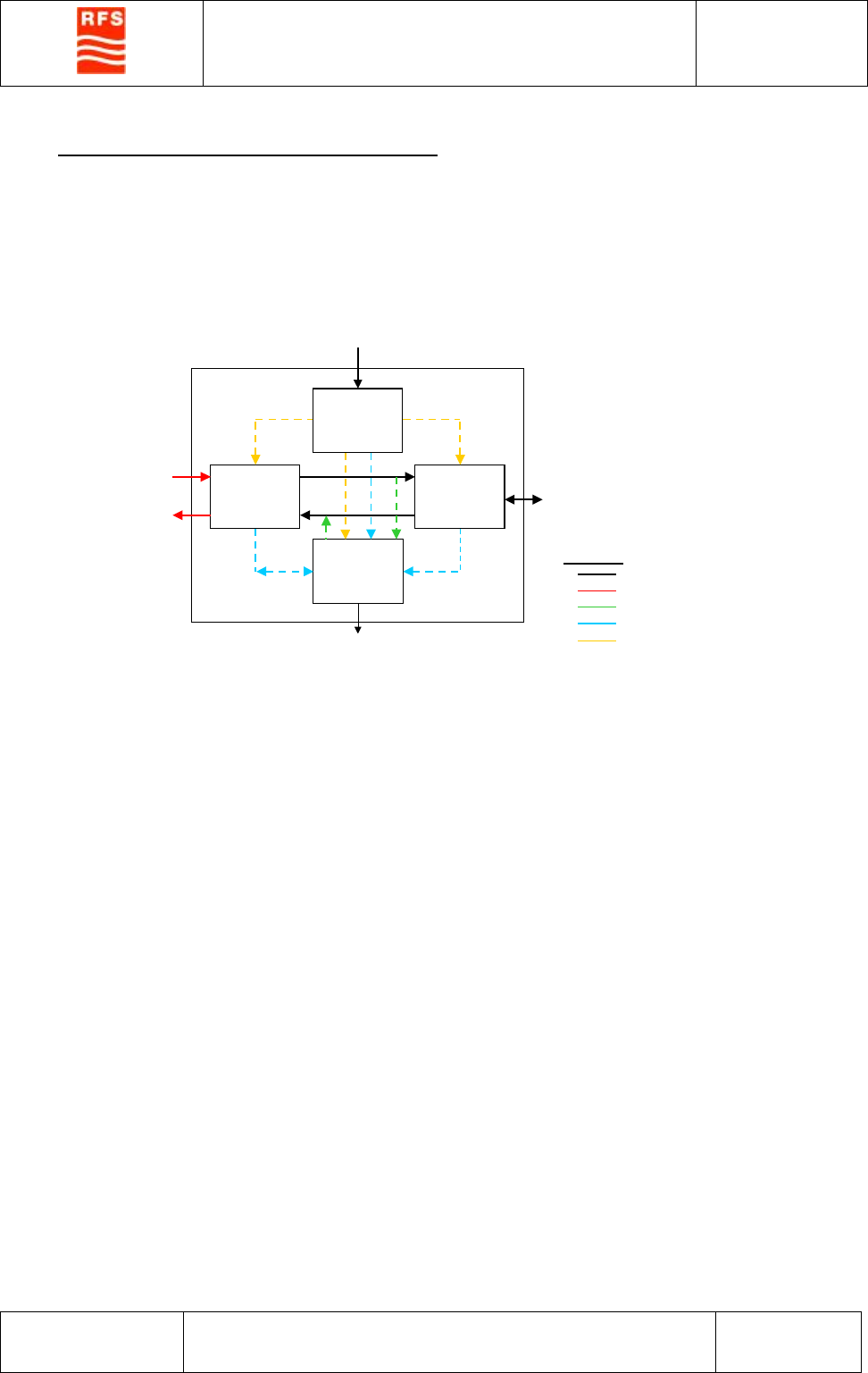
User Handbook L-RU Revision C
CONFIDENTIAL
PROPRIETARY Reg. No.: User Handbook 1100182-C.DOC Page 12 of 29
3.1 Block Schematics of the Remote Unit
Figure 5 shows the functional block schematic of the remote unit, which basically identifies
the main building blocks and their interactions. All external interfaces are clearly identified
as arrows crossing the boundary of the remote unit.
E / O
PSU
Active
RF
Monitoring
DL
Optical Input
RF
Input / Output
Status LEDs
Power Supply
Legend:,
RF Connection
Optical Link
Pilot Tone
Monitoring Control
Module Power Supply
UL
Optical Output
Figure 5: Functional Block Schematic of the Remote Unit
• PSU: internal power supply for RU
• E/O: Optical transmitter and receiver integrated into one transceiver module
• Active RF: The combination of all passive and active modules for uplink and
downlink including supporting electronics
• Monitoring: All electronics for alarming.
The Remote Unit consists of the following functional building blocks
• The optical transceiver
• The pilot tone monitoring
• The downlink path
• The uplink path
• Duplexer
• Power supply
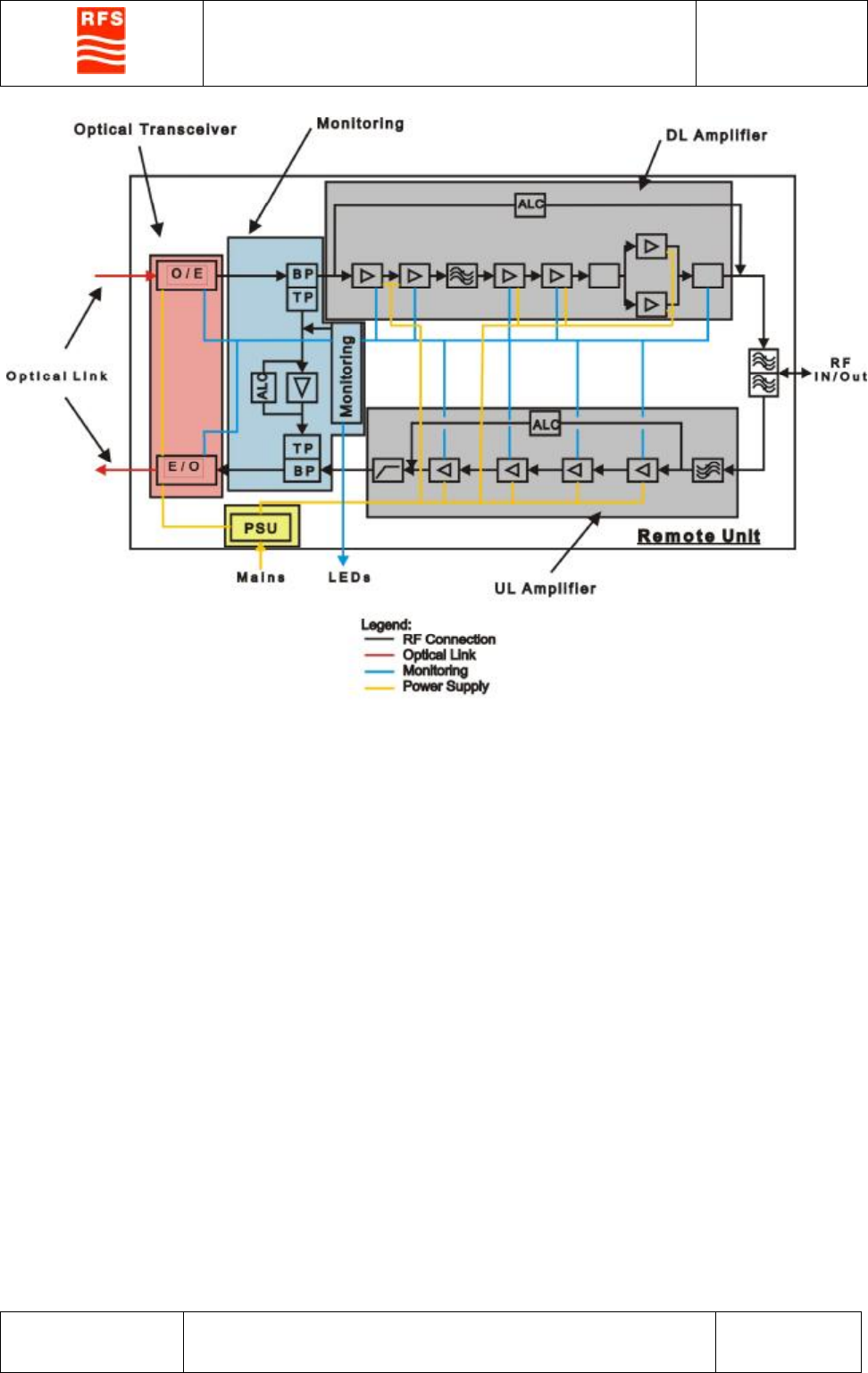
User Handbook L-RU Revision C
CONFIDENTIAL
PROPRIETARY Reg. No.: User Handbook 1100182-C.DOC Page 13 of 29
Figure 6: Block schematic of the Remote Unit
A detailed block schematic of the RU is shown in Figure 4 indicating the optical transceiver
part in red, the monitoring electronic in blue, the PSU in yellow and the RF amplifier block
in grey.
In downlink, an optical receiver ORx converts the optical input signals from the Optical
Master Unit to RF signals. The BP/LP separates RF communications signals from the
monitoring pilot tone. A cascade of amplifiers provides sufficient RF gain imbedded in an
ALC which keeps the output power level constant compensating optical losses of the opti-
cal link. The duplexer separates downlink output signals from uplink input signals.
In uplink, the RF amplifier is embedded in an ALC, which compensates varying input
power levels. The output power into the laser OTx is limited protecting the laser against
damages. The BP/LP module combines the RF signals with the pilot tone in UL.
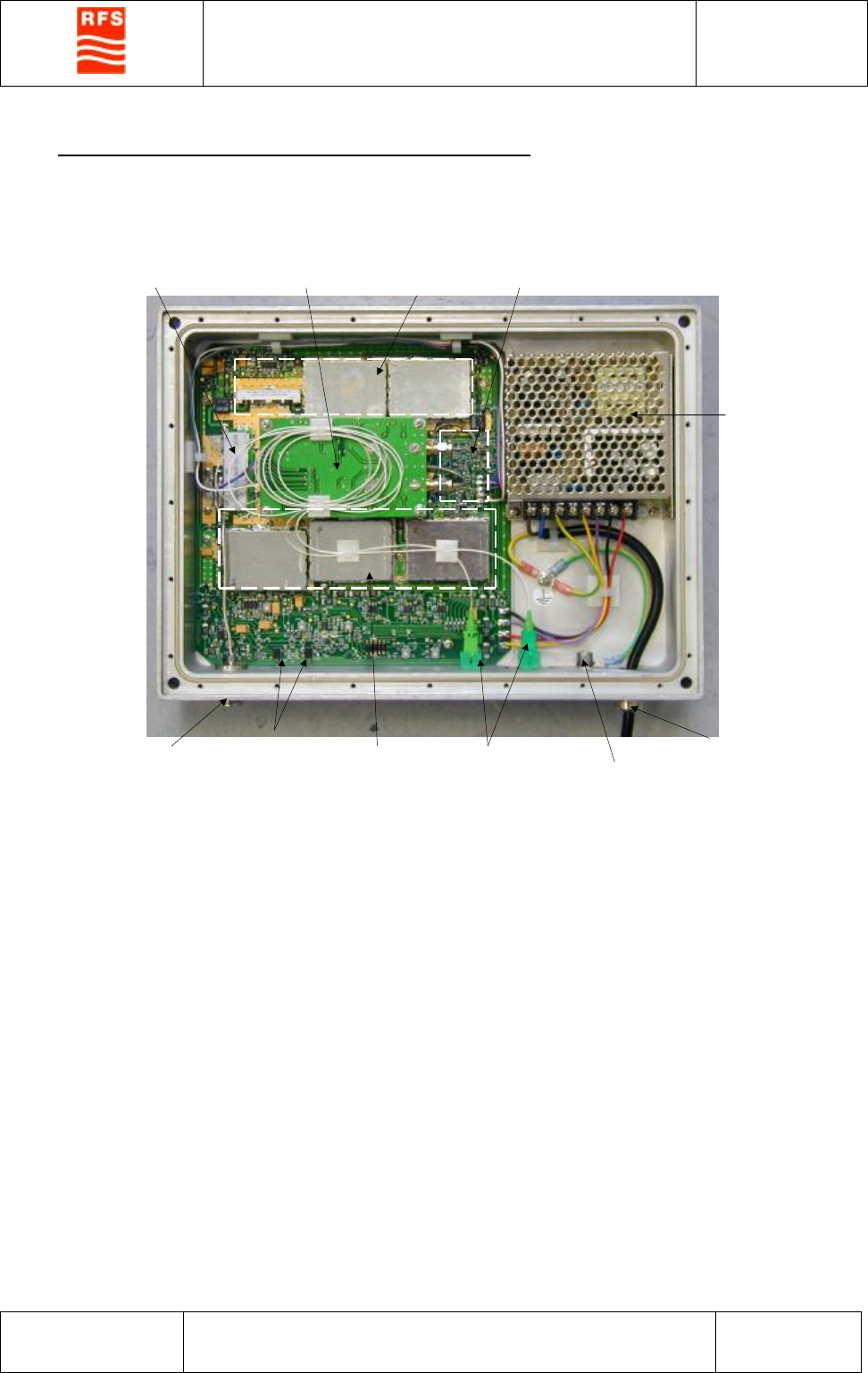
User Handbook L-RU Revision C
CONFIDENTIAL
PROPRIETARY Reg. No.: User Handbook 1100182-C.DOC Page 14 of 29
3.2 Functional Building Blocks of the Remote Unit
A picture of the inner arrangement of the remote unit is shown in Figure 7.
AC Power Cable
SC/APC Optical IN / OUT
Connectors
RF N- Connector
PSU
Monitoring LED
Downlink path
Earthing Clamp
Uplink path Pilot Tone Monitoring Optical Module Duplexer
Figure 7: Inner arrangement of the Remote Unit
The optical transceiver and the power supply are separate modules. The pilot tone moni-
toring, downlink, uplink and the duplexer are integrated on one PCB. All modules of the
RU are integrated in a cast housing with integrated heat sink designed for wall mounting.
The housing has a protection against splash water, dust and dirt. All connections are ar-
ranged on the bottom side. The attractive design and the protection class IP 54 allows in-
stalling the RU in various environments.
3.2.1 Uplink
The uplink path mainly consists of a four-stage amplifier with two integrated filters, an ALC
and a limiter to protect the laser in UL against high power levels and to avoid non-linear
operation.
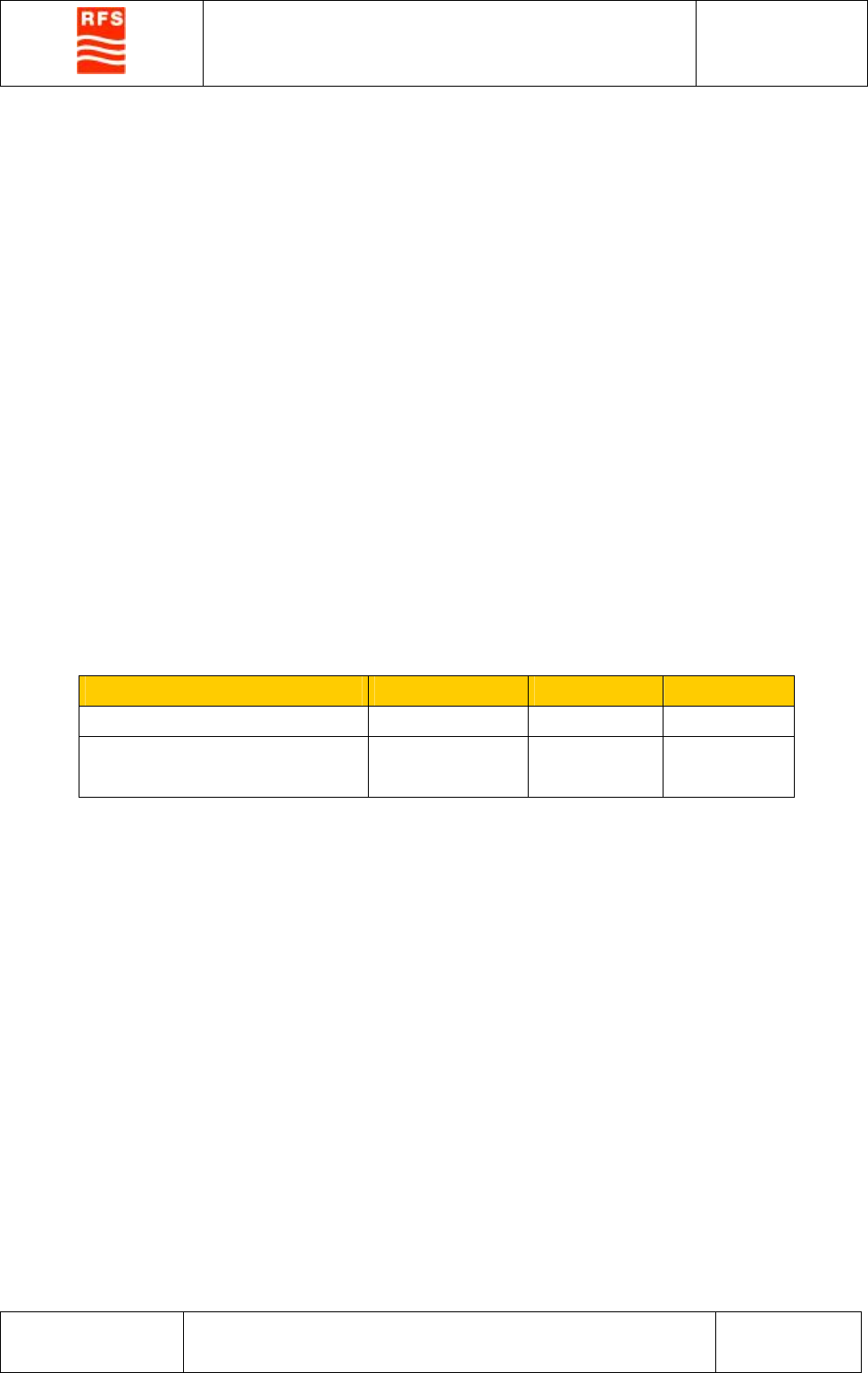
User Handbook L-RU Revision C
CONFIDENTIAL
PROPRIETARY Reg. No.: User Handbook 1100182-C.DOC Page 15 of 29
The ALC compensates for different uplink input levels per carrier providing optimised UL
performance with regard to spurious free dynamic range.
3.2.2 Downlink
The downlink path includes a five-stage amplifier with balanced power amplifier, filters and
an ALC, which automatically operates the RU according to ETSI requirements. The
downlink path is equipped with a monitoring to control the RF-amplifiers. Each amplifier
stage can generate an alarm by controlling the DC-current.
3.2.3 Monitoring
All amplifier stages in downlink and uplink as well as the optical transceiver are monitored.
Failures are logically combined to a resulting summary alarm that results in a switch-off of
the pilot tone.
The alarm matrix of the RU is shown in Table 1 below.
Alarm LED OK Failure
Power supply Main Power green Off
Summary alarm (RF am-
plifiers, optical modules) Monitoring green red
Table 1 – Alarm matrix of the RU
3.2.4 Function of ALC
The main part of this ALC system is a detector circuitry. It converts an RF signal to an
equivalent DC voltage at its output. The detected voltage is compared with a reference
value adjusting an electrical controlled attenuator. Thus, the RF power level at the antenna
port is kept constant to maximum and no manual leveling is required.
3.2.5 Duplexer
The duplexer at the antenna port is a high performance ceramic duplexer separating uplink
and downlink RF-bands.

User Handbook L-RU Revision C
CONFIDENTIAL
PROPRIETARY Reg. No.: User Handbook 1100182-C.DOC Page 16 of 29
4 Specifications
4.1 Electrical Specifications
Frequency range CDMA800
Model no. L-RU800-2
Uplink 824 – 849 MHz
Downlink 869– 894 MHz
Bandwidth 25 MHz
Frequency range SMR800
Model no. L-RUSMR800-2
Uplink 806 – 824 MHz
Downlink 851 – 869 MHz
Bandwidth 18 MHz
Frequency range Home Land Security
Model no. L-RU700-2
Uplink 764 – 776 MHz
Downlink 794 – 806 MHz
Bandwidth 12 MHz
Frequency range PCS1900
Model no. L-RU1900-2
Uplink 1850 – 1910 MHz
Downlink 1930 – 1990 MHz
Bandwidth 60 MHz
Frequency range AWS
Model no. L-RU1721-2
Uplink 1710 – 1755 MHz
Downlink 2110 – 2155 MHz
Bandwidth 45 MHz

User Handbook L-RU Revision C
CONFIDENTIAL
PROPRIETARY Reg. No.: User Handbook 1100182-C.DOC Page 17 of 29
Composite Output Power in DL 22 dBm typical
RF impedance 50 Ω
Return loss > 10 dB typical
Input voltage AC 115/230 V ±10%, 50/60 Hz ±5%,
autoranging
Gland with 1.5m cables
Power consumption < 30 W
ALC operation (UL window at RF in/out port) ALC active: - 55dBm to -35 dBm *)
*) target window for plug-and-play mode
Linear mode: < -55 dBm
Master Unit see User Handbook L-MU series

User Handbook L-RU Revision C
CONFIDENTIAL
PROPRIETARY Reg. No.: User Handbook 1100182-C.DOC Page 18 of 29
4.2 Mechanical Specifications
Size height: 240 mm
width: 320 mm
depth: 70 mm
Colour black (RAL 9005)
scratch resistant
Cooling: convection cooling, without fans
Weight: approx. 5,8 kg
Operating Temperature Range -10°C to + 50°C
Storage Temperature Range -20°C to + 75°C
Relative humidity 0% to 90%
(non-condensing)
RF Connectors: N type female
Earthing: M8 bolt
Location of the interfaces and control element on bottom when wall mounted
Environmental Protection: IP 54
4.3 Optical Link
Fiber optic type mono-mode, 9 / 125
Number of fibers 2 (one for UL, one for DL)
Optical connectors SC / APC
Wavelength 1310 nm
Optical attenuation max. 5 km (3miles) distance
or 6 dB optical attenuation
4.4 Compliance
EMC ETSI EN 301 489-1
FCC FCC part 15/ 22/ 24/ 27/ 90
Safety IEC / EN60950
Optic Laser Diode according to IEC / EN 60 825 – 1, class 1
Fiber Optic Link according to IEC / EN 60 825 – 2

User Handbook L-RU Revision C
CONFIDENTIAL
PROPRIETARY Reg. No.: User Handbook 1100182-C.DOC Page 19 of 29
5 Module Descriptions and Specifications
5.1 Optical Transceiver
5.1.1 Optical Transmitter
Wavelength 1310 nm, single mode
Optical Output Power 3 dBm typical
Modulation gain 0,08 mW/mA
5.1.2 Optical Receiver
Wavelength 1310 nm, single mode
Maximum input power 3 dBm optical
5.2 Power Supply
The in-built PSU is a high reliability, wide input range, and high efficient AC-DC converter
with four outputs at 5 V, 12 V, -12 V and 24 V. To reduce the outgoing disturbance an EMI-
filter is built in. To reduce the inrush current at start-up, a soft start circuit is implemented.
The output is short circuit, overload and over voltage protected.

User Handbook L-RU Revision C
CONFIDENTIAL
PROPRIETARY Reg. No.: User Handbook 1100182-C.DOC Page 20 of 29
6 Installation and Commissioning
6.1 General Statements
6.1.1 Safety Considerations / Sicherheitshinweise (English / Deutsch)
Safety Considerations
PTFE and PTFE Composite Materials
Materials should never be heated to the point where smoke or fumes are evolved.
Any person feeling drowsy after coming into contact with PTFE especially dust or
fumes should seek medical attention.
Sicherheitshinweise
PTFE und PTFE Verbundwerkstoffe
PTFE und PTFE Verbundwerkstoffe dürfen nicht derart erhitzt werden, dass es zu
Rauchentwicklung kommt. Personen die mit solchem Rauch in Berührung kommen
und sich unwohl fühlen (z.B. Schläfrigkeit), sollten dringend medizinische Beratung
in Anspruch nehmen.
6.1.2 Packing List
Additionally to the remote unit following parts are enclosed to the delivery set:
§ User Handbook L-RU
§ Test report L-RU
§ Packing list
§ 4 screws, 4 washers, 4 dowels
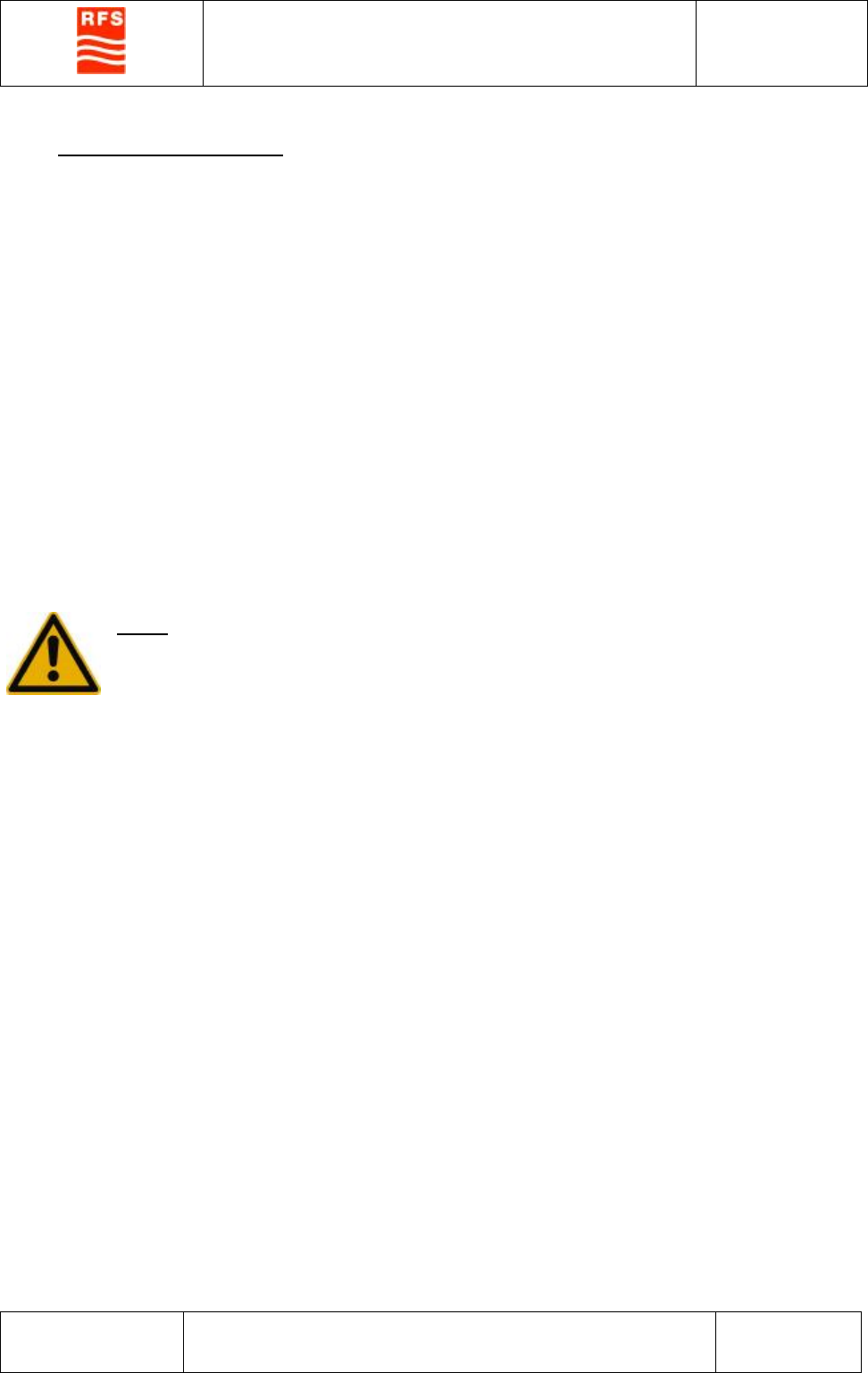
User Handbook L-RU Revision C
CONFIDENTIAL
PROPRIETARY Reg. No.: User Handbook 1100182-C.DOC Page 21 of 29
6.2 Installation Procedure
The installation may only be carried out by qualified personnel that is familiar with the haz-
ards involved and the relevant statutory regulations.
Before begin of the installation of the RU, all RF cable and optical cable should be installed
first.
The procedure for installing the L-RU is generally as follows:
1. Transport the RU to the chosen site in its packaging.
2. Remove the RU from its packaging and check that there are no obvious signs of
physical damage. If the unit is physically damaged do not proceed with the in-
stallation.
3. Drill or fit four wall fixings to which the RU is to be fitted. For the physical dimen-
sions of the wall fixings refer to Figure 8. The type of fixings will depend on the
construction of the wall. It has to be ensured that the wall fixings are adequate
for a total weight of more than 6 kg.
Note: The provided dowels in the accessories are suitable for installation
in indoor areas (closed spaces) only and for following wall constructions.
• Concrete
• Pre-stressed hollow-core concrete slabs
• Natural stone with dense structure
• Solid brick
• Sand-lime solid brick
• Solid block made from lightweight concrete
• Aircrete
• Solid panel made from gypsum
• Hollow block made from lightweight concrete
• Slabs made of perforated bricks
• Hollow concrete blocks etc.
For the installation in other environment (e. g. tunnel) or other wall construction an-
other dowel must be used, which is suitable for this environment and wall construc-
tion.
4. Fit and secure the RU on to the fixings. It is strongly recommended that all four
fixing points be used.
5. Earth the RU in accordance with international and local recommendations and
requirements.
6. Connect the RU to RF distributing DAS or radiating cable. Connect the two opti-
cal link cables from and to the assigned MU and plug in the power cable.
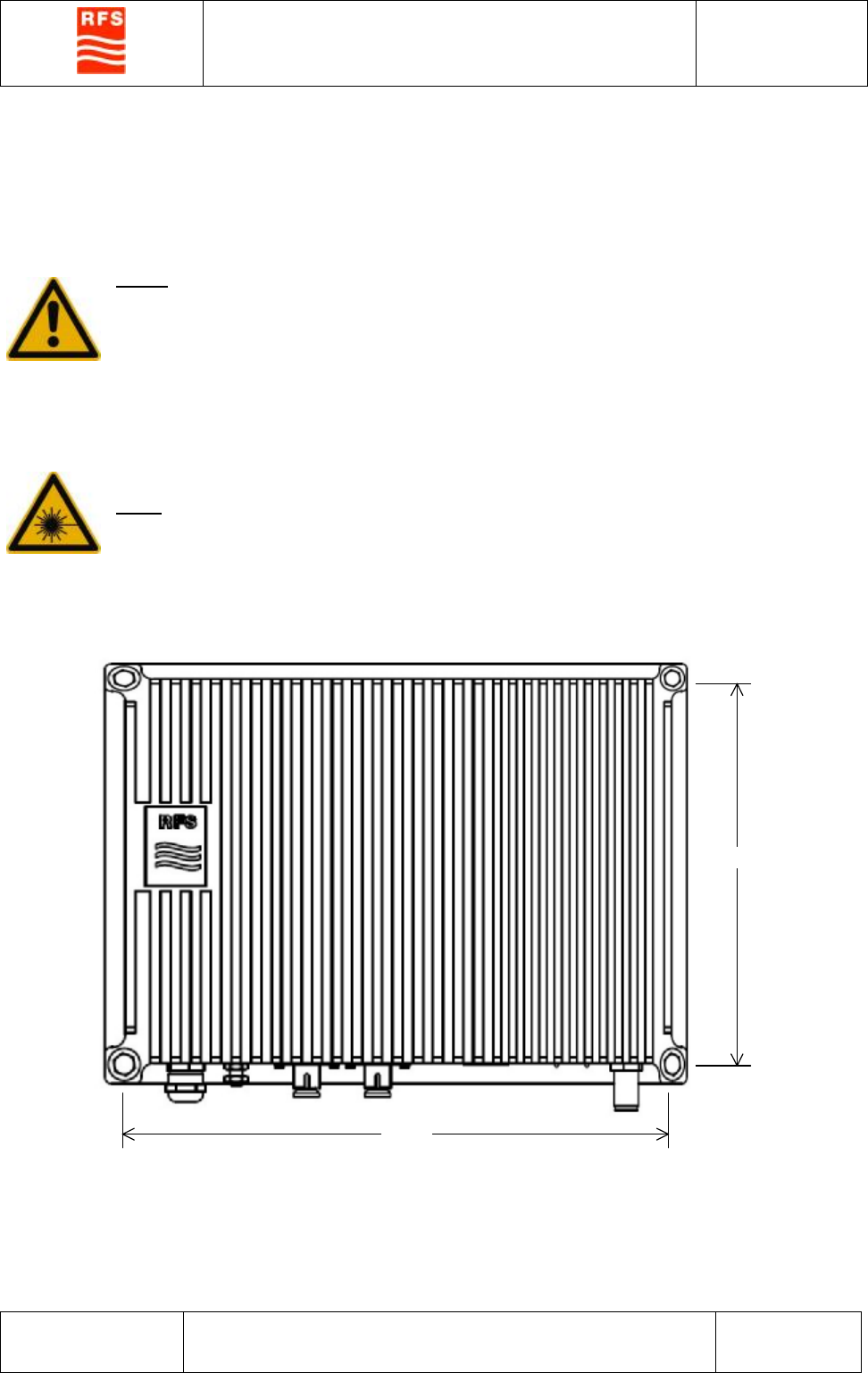
User Handbook L-RU Revision C
CONFIDENTIAL
PROPRIETARY Reg. No.: User Handbook 1100182-C.DOC Page 22 of 29
7. Ensure that all the cables leaving the RU first travel downward to ensure that
any moisture is directed away from the RU. This is important for installation in
tunnel environment.
Note: It is important that the above installation instructions are followed in
the sequence presented to ensure a correct and save installation.
Ensure a suitable mains power supply is available adjacent to the RU. Connect the RU
main cables to the mains supply in accordance with local wiring.
Note: Avoid looking directly into the optical connectors of the RU if no op-
tical cables or protective sleeve are installed and the RU is switched on.
213 mm
301 mm
Figure 9: Drill Template for wall installation

User Handbook L-RU Revision C
CONFIDENTIAL
PROPRIETARY Reg. No.: User Handbook 1100182-C.DOC Page 23 of 29
6.3 Commissioning Procedure
The ClearFill®Space1 system (consisting of MU and RU) is equipped with a combination of
ALCs, minimum one at the input and one at the output. The dynamic range of the individ-
ual ALCs and their reaction time is adjusted to each other. At least the whole system oper-
ates in a balanced way providing defined power levels at the output of the system within
the specified power levels at the system inputs.
Due to the self-levelling functionality no commissioning and testing of the ClearFill®Space1
system is necessary. The system can be set into operation as plug & play compensating
automatically for fiber optical losses, for changes of number of operating RF carriers and
for all types of temperature and aging effects.

User Handbook L-RU Revision C
CONFIDENTIAL
PROPRIETARY Reg. No.: User Handbook 1100182-C.DOC Page 24 of 29
7 Maintenance, Repair and Warranty
7.1 Introduction
The RU is designed and built to require no periodic maintenance. As long as the unit is
kept away from extreme temperatures and moisture, it should provide long-term, carefree
operation.
It is strongly recommended that no invasive procedures are performed on the unit in an
attempt to verify performance. See section 7.2 for recommended routine performance
variation checks.
7.2 Routine Checks
Although the RU is a low-maintenance unit, it is recommended to routinely verify the per-
formance of the RU by making test calls or detailed system checks on the actual radio
coverage. Several test calls should be made at different positions within each area to get
an overall picture of the system performance. This is by far the best way to check the sys-
tem as it tests the whole system from an operational viewpoint as seen by the users.
It is strongly recommended that no invasive procedures be performed on the unit in an
attempt to verify performance unless a serious problem with performance has been identi-
fied as described above. Any such invasive procedures are more likely to do damage to
the system and create intermittent performance than to be of any practical value.
7.3 Repair
Repairs may only be carried out by qualified personnel that are familiar with both the haz-
ards involved and the relevant statutory regulations. Unauthorized modifications or repairs
invalidate the warranty claim.
Before contact RFS customer service for repair request please prove the checklist in sec-
tion 7.4 (Troubleshooting).
For returns, repairs and ordering contact your RFS customer service or
technical.consulting@rfsworld.com.

User Handbook L-RU Revision C
CONFIDENTIAL
PROPRIETARY Reg. No.: User Handbook 1100182-C.DOC Page 25 of 29
7.4 Troubleshooting
You have obtained a state-of-the-art product, which is reliable and operationally safe.
Nevertheless, problems or malfunctions may occur. Following we will present strategies
how to eliminate possible problems.
The safety instructions must be observed (see notes below the table)!
Pease follow the procedures for the troubleshooting in the prescribed order.
Checklist RU
Symptoms Reason Procedure
• All RU LED are off.
The power supply is inac-
tive.
1. Check the AC voltage
2. Check the connectors of AC cable
3. Check the AC power cable for
damages
The outputs of the PSU
have over or under volt-
age
Reset the RU by switching Off and
after a few seconds On of the AC
power
• RU PSU LED is
red.
PSU is defect Please contact RFS customer ser-
vice for repair or replacement of RU
• RU Monitoring
LED is red.
Problem with optical sig-
nal
Please check the system trouble-
shooting list (see next page).
Note: Always remove AC power cable before checking or changing fuses.
115 / 230 VAC can be lethal.
Note: To avoid shock, injury or damage to the RU: use only fuses with
the amperage, interrupt, voltage and speed ratings specified.
Note: Don’t open housing of RU. Warranty exclusion in case housing has
been opened!

User Handbook L-RU Revision C
CONFIDENTIAL
PROPRIETARY Reg. No.: User Handbook 1100182-C.DOC Page 26 of 29
System Checklist
The safety instructions must be observed (see notes below the table)!
The following troubleshooting refers to specific alarm LED indications on MU and RU in a
ClearFill®Space1 system environment. Please follow the procedures for the troubleshoot-
ing in the prescribed order. For guidance the column “Symptoms” gives specific LED
status information combinations at MU and RU.
Symptoms Reason Procedure
• MU Summary OTx
LED is red
One or more optical
transmitter is inactive
Please contact RFS customer ser-
vice for repair or replacement of RU
• MU Link LED to
RU is red No optical signal
1. Check the optical connectors of
the inactive link for fastening or
damage
2. Check the optical cable between
MU and RU for damage
3. Clean with special equipment the
ferrules at the optical connectors
4. Check the following variety of
troubleshooting, described below
No optical signal in UL
1. Check the optical connectors of
the UL (on the MU and RU site) for
fastening or damage
2. Check the optical cable in UL for
damage
• MU Link LED is
red / RU Monitor-
ing LED is green OTx of MU is inactive
(in this case summary
OTx LED is red as well)
3. Please contact RFS customer ser-
vice for repair or replacement of
MU

User Handbook L-RU Revision C
CONFIDENTIAL
PROPRIETARY Reg. No.: User Handbook 1100182-C.DOC Page 27 of 29
Symptoms Reason Procedure
No optical signal
1. Check the optical connectors of
the UL and DL (on the MU and RU
site) for fastening or damage
2. Check the optical cable in UL and
DL for damage
3. Clean with special equipment the
ferrules at the optical connectors
OTRx of MU is inactive
4. Connect the optical cables of the
failure link to the other optical link
connectors (in case of L-MU2 and
L-MU4) or to the spare device if
available (for L-MU1). If the link
status OK, then contact RFS cus-
tomer service for repair or re-
placement of MU.
Optical cable is inactive
5. If the link status is on failure (see
point 4) retry the communication
with spare devices (MU and RU) if
available.
6. In case of failure status the optical
cable is out of order.
• MU Link LED is
red / RU Monitor-
ing LED is red
MU or RU is inactive
7. In case of OK status (see point 5)
is MU or RU is inactive. The failure
unit can be detected by sequential
change of the only one unit (MU or
RU). Please contact RFS cus-
tomer service for repair or re-
placement of this unit.
• No signal on data /
monitoring inter-
face
No data available
1. Check the data connectors for fas-
tening or damage
2. Check the data cable for damage

User Handbook L-RU Revision C
CONFIDENTIAL
PROPRIETARY Reg. No.: User Handbook 1100182-C.DOC Page 28 of 29
7.5 Warranty
The Warranty time is 1 year beginning with the delivery of the equipment. Warranty ser-
vices do not extend the warranty time. The warranty is not valid for the following:
• Damage caused by improper use
• Damage caused by non-adherence to user handbook
• Devices which have been opened provided this is not described in the user
handbook for maintenance purposes.
• Devices whose serial number labels have been changed, damaged, removed or
exchanged.
• Devices whose warranty seals are changed, damaged, removed or broken.
We will correct any fault free of charge or exchange item (excluding shipment), if
• It can be proved that they are manufacturing faults.
• The faults are reported immediately.
• The faults are reported within the warranty time

User Handbook L-RU Revision C
CONFIDENTIAL
PROPRIETARY Reg. No.: User Handbook 1100182-C.DOC Page 29 of 29
8 Notes